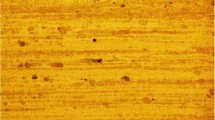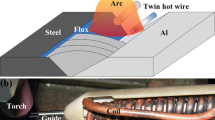Abstract
Steel-aluminum dissimilar metal welding has a robust application demand in automobile lightweight. However, the formation of Fe-Al intermetallic compounds (IMCs) reduces the steel-aluminum welded joint’s mechanical properties (tensile strength or linear load). This paper reviews the research results of transition layer and filler wire in improving the mechanical properties of steel-aluminum laser welding joint (SALWD). The mechanism of improving the mechanical properties of SALWD by filler wire and transition layer is summarized. The transition layer’s development direction uses multi-element, trace rare earth elements and high-strength fiber. The development direction of filler wire is to develop the low melting point, good wettability, and high-strength filler wire. This article has reference value for researching dissimilar metal welding and transition layer and welding wire materials.















Similar content being viewed by others
Data availability
The data sets supporting the results of this article are included within the article.
References
Zhang P, Shi H, Tian Y, Yu Z, Wu D (2021) Effect of zinc on the fracture behavior of galvanized steel/6061 aluminum alloy by laser brazing. Weld World 65:13–22. https://doi.org/10.1007/s40194-020-00992-2
Liu FC, Dong P (2021) From thick intermetallic to nanoscale amorphous phase at Al-Fe joint interface: roles of friction stir welding conditions. Scripta Mater 191:167–172. https://doi.org/10.1016/j.scriptamat.2020.09.031
Silvayeh Z, Domitner J, Sommitsch C, Hartmann M, Karner W, Götzinger B (2020) Mechanical properties and fracture modes of thin butt-joined aluminum-steel blanks for automotive applications. J Manuf Process 59:456–467. https://doi.org/10.1016/j.jmapro.2020.09.050
Nishino S (2020) Joining mechanism on resistance spot-welding between aluminum alloy and steel and evaluation of joining strength
Livieri P, Tovo R (2021) Fatigue strength of aluminium welded joints by a non-local approach. Int J Fatigue 143:106000. https://doi.org/10.1016/j.ijfatigue.2020.106000
Dinda SK, Srirangam P, Roy GG (2020) Defects comparison between single- and double-sided electron beam welded dissimilar DP600 Steel to 5754 Al alloy joints: X-ray tomography study, San Diego, CA, United states, 2020[C]. Springer Sci Busin Media Deutschland GmbH
Wallerstein D, Lusquiños F, Comesaña R, Del Val J, Riveiro A, Badaoui A, Pou J (2021) Dissimilar unbeveled butt joints of AA6061 to S235 structural steel by means of standard single beam fiber laser welding-brazing. J Mater Process Technol 291:116994. https://doi.org/10.1016/j.jmatprotec.2020.116994
Liu X, Lan S, Ni J (2014) Analysis of process parameters effects on friction stir welding of dissimilar aluminum alloy to advanced high strength steel. Mater Des 59:50–62. https://doi.org/10.1016/j.matdes.2014.02.003
Fang Y, Jiang X, Mo D, Zhu D, Luo Z (2019) A review on dissimilar metals’ welding methods and mechanisms with interlayer. Int J Adv Manufact Technol 102:2845–2863. https://doi.org/10.1007/s00170-019-03353-6
Takata N, Nishimoto M, Kobayashi S, Takeyama M (2014) Morphology and formation of Fe-Al intermetallic layers on iron hot-dipped in Al-Mg-Si alloy melt. Intermetallics 54:136–142. https://doi.org/10.1016/j.intermet.2014.06.003
Pp A, Gsb C, Db C, Ds A, Gf C (2007) Generation of aluminium–steel joints with laser-induced reactive wetting. Mater Sci Eng A 444:327–338. https://doi.org/10.1016/j.msea.2006.09.111
Yang X (2014) Effect of powder components on quality of laser welding aluminum to steel with filler powder. Master Changchun Uni Sci Technol Mechan Manufact Auto
Yan LI, Ning L, Jiankang H, Ding F (2018) Structure and property of aluminum-steel dissimilar metal joint by laser fusion brazing with addition of different alloy powders. Mater Mechan Eng 42:30–35, 41. https://doi.org/10.11973/jxgccl201806006
Dianwu Z, Jinshui L, Yuanzhi L, Laiqin Z, Jingchun P (2018) Microstructure and mechanical properties of deep penetration laser welding joints in steel/aluminum with Si powder addition. J Mechan Eng 54:58–65. https://doi.org/10.3901/JME.2018.14.058
Yuan-zhi L, Jin-shui L, Dian-wu Z, Zhe T, Xiao J, Lin-xi HU (2016) Laser lap welding joints in dual phase steel/aluminum alloy with Mn powder addition[Z]. 26:1632–1640
Li T, Zhou D, Yan Y, Zhang S, Liu J (2020) Effect of Ti foil on microstructure and mechanical properties of laser fusion welding of DP590 dual-phase steel to 6022 aluminum alloy. Mater Sci Eng A 796:139929. https://doi.org/10.1016/j.msea.2020.139929
Chen S, Huang J, Ma K, Zhao X, Vivek A (2014) Microstructures and mechanical properties of laser penetration welding joint with/without Ni-foil in an overlap steel-on-aluminum configuration. Metall Mater Trans A 45:3064–3073. https://doi.org/10.1007/s11661-014-2241-1
Geng Y, Akbari M, Karimipour A, Karimi A, Soleimani A, Afraned M (2019) Effects of the laser parameters on the mechanical properties and microstructure of weld joint in dissimilar pulsed laser welding of AISI 304 and AISI 420. Infra Phys Technol 103. https://doi.org/10.1016/j.infrared.2019.103081
Sharifi M, Akbari M (2019) Experimental investigation of the effect of process parameters on cutting region temperature and cutting edge quality in laser cutting of AL6061T6 alloy. Optik 184:457–463. https://doi.org/10.1016/j.ijleo.2019.04.105
Das T, Paul J (2020) Resistance spot welding of similar and dissimilar metals: the effect of graphene interlayer. JOM 72:2863–2874. https://doi.org/10.1007/s11837-020-04159-8
Das T, Das R, Paul J (2020) Resistance spot welding of dissimilar AISI-1008 steel/Al-1100 alloy lap joints with a graphene interlayer. J Manuf Process 53:260–274. https://doi.org/10.1016/j.jmapro.2020.02.032
LI Y (2015) Effect of different processing methods on the surface of steel on quality of laser welding aluminum to steel with filler power. Master Changchun Uni Sci Technol Mechan Manufact Auto. http://www.wanfangdata.com.cn/details/detail.do?_type=degree&id=D743966
Chen X (2019) A study on microstructure and properties of steel/aluminum laser deep penetration welded joint. Master Soochow Uni. http://kns.cnki.net/KCMS/detail/detail.aspx?FileName=1019262514.nh&DbName=CMFD2020
Zhou D, Tian W, Peng L, Zhang Y, Chen G (2014) Laser lap welding of steel and aluminum alloy with Cu, Pb metal sandwich addition. Rare Met Mater Eng. 43:1181–1186
Yuan J, Zhou D, Chen S, Sun J, Hou D (2017) Interfacial microstructure and properties of steel/aluminum powder additive. J Mater Eng. 45:123–128
Lu Y (2016) Study on the behavior and mechanism in DP steel/aluminum alloy laser welding with powder addition[Z]. Hunan Uni Master
Zhang L, Zhou D, Liu J, Xu S, Qiao X, Li S (2013) Laser welding of steel/aluminum dissimilar metal with powder addition. Chin J Nonferr Met 23:3401–3409. https://doi.org/10.19476/j.ysxb.1004.0609.2013.12.020
Jian-kang H, Zi-yi W, Ning L, Shu-rong YU, Ding F (2018) Effect of metal coating on microstructure and properties of aluminum/steel laser welding-brazing joint. J Mater Eng 46:99–105. https://doi.org/10.11868/j.issn.1001-4381.2016.001568
Gang W, Xuelong C, Caiwang T, Junjun J, Chang X (2020) Effect of Ni/Si foil interlayer on microstructure and mechanical properties of laser welded aluminum/steel joints. Transact China Weld Insti 41:84–89. https://doi.org/10.12073/j.hjxb.20191022001
Liu D, Wang J, Xu M, Jiao H, Tang Y, Li D, Zhao L et al (2020) Evaluation of dissimilar metal joining of aluminum alloy to stainless steel using the filler metals with a high-entropy design. J Manuf Process 58:500–509. https://doi.org/10.1016/j.jmapro.2020.08.031
Jianling S, Sanbao Y, Chunli Y, Guangchao M (2008) Research on alloy agent for improving welded joint properties of aluminum to steel dissimilar material. Aeronaut Manufact Technol 12:26. https://doi.org/10.16080/j.issn1671-833x.2008.12.006
Jie W, Songbai X, Wenpan F, Yilong H, Peng Z (2019) Present status and development trend for brazing aluminum to steel [J]. 33(21):3533–3540
Windmann M, Roettger A, Kuegler H, Theisen W, Vollertsen F (2015) Laser beam welding of aluminum to Al-base coated high-strength steel 22MnB5. J Mater Process Technol 217:88–95. https://doi.org/10.1016/j.jmatprotec.2014.10.026
Hd A, Wh A, Yd A, Xw A, Cd B (2012) Dissimilar metal joining of aluminum alloy to galvanized steel with Al–Si, Al–Cu, Al–Si–Cu and Zn–Al filler wires. J Mater Process Technol 212:458–464. https://doi.org/10.1016/j.jmatprotec.2011.10.009
Xia H, Li L, Ma N, Tan C, Gong J (2020) Influence of energy ratio on dual-spot laser welded-brazed Al/steel butt joint. J Mater Process Technol 281. https://doi.org/10.1016/j.jmatprotec.2020.116624
Jianxun Z, Xu J, Zhenzhen XU, Guifeng Z (2020) Study on characteristics of laser welding-brazing of 6061 aluminum alloy to SPCC cold rolled steel. J Mechan Eng 56:41–49. https://doi.org/10.3901/JME.2020.06.041
Xue J, Li Y, Chen H, Zhu Z (2018) Effects of heat input on wettability, interface microstructure and properties of Al/steel butt joint in laser-metal inert-gas hybrid welding-brazing. J Mater Process Technol 255:47–54. https://doi.org/10.1016/j.jmatprotec.2017.11.063
Gao W, Yan Q, Huang J (2014) Microstructure and mechanical property of laser wire fusion brazing welded butt joints of steel/aluminum dissimilar metal[Z]. 85–90. https://doi.org/10.1016/j.jmatprotec.2019.116467
Laukant H, Wallmann C, Muller M, Korte M, Stirn B, Haldenwanger HG, Glatzel U (2005) Fluxless laser beam joining of aluminium with zinc coated steel. Sci Technol Weld Join 10:219–226. https://doi.org/10.1179/174329305X37051
Huang R, Tan C, Sun Y, Gong X, Wu L, Chen B, Zhao H et al (2021) Influence of processing window on laser welding-brazing of Al to press-hardened 22MnB5 steel. Opt Laser Technol 133:106566. https://doi.org/10.1016/j.optlastec.2020.106566
Su J, Yang J, Li Y, Yu Z, Chen J, Zhao W, Liu H et al (2020) Microstructure and mechanical properties of laser fusion welded Al/steel joints using a Zn-based filler wire. Opt Laser Technol 122:105882. https://doi.org/10.1016/j.optlastec.2019.105882
Fengyu D, Caiwang T, Shenghao M, Guoxin LI, Hongyun Z, Jicai F (2017) Laser welding-brazing characteristics of dual-phase steel DP590/Al alloy 6061. Elect Weld Mach 47:12–17. https://doi.org/10.7512/j.issn.1001-2303.2017.09.03
Yu G, Chen S, Zou T, Li S, Huang J, Yang J, Zhao Z et al (2020) Laser beam joining of Al/steel dissimilar metals with Sn-Zn filler wire in overlap configuration. J Manuf Process 60:481–493. https://doi.org/10.1016/j.jmapro.2020.10.079
Funding
This work was supported by the National Natural Science Foundation of China (NSFC) (62004050, 52165056), the key project of Guangxi Natural Science Foundation (2019JJD160010), Innovation Project of Guangxi Graduate Education (YCBZ2021073), the GUET Excellent Graduate Thesis Program (18YJPYBS01, 19YJPYBS02), the Innovation Project of GUET Graduate Education (2020YCXS010, 2021YCXS001).
Author information
Authors and Affiliations
Contributions
Conceptualization, date curation, and writing: Yaowu Zhao; project administration: Yuhong Long; proofreading: Zhaoyan LI.
Corresponding author
Ethics declarations
Ethical approval
Not applicable.
Consent to participate
We confirm that the manuscript has been read and approved by all named authors.
Consent to publish
The authors agree to publication in The International Journal of Advanced Manufacturing Technology.
Competing interests
The authors declare no competing interests.
Additional information
Publisher's Note
Springer Nature remains neutral with regard to jurisdictional claims in published maps and institutional affiliations.
Rights and permissions
About this article
Cite this article
Zhao, Y., Long, Y. & Li, Z. Research progress of transition layer and filler wire for laser welding of steel and aluminum dissimilar metals. Int J Adv Manuf Technol 119, 4149–4158 (2022). https://doi.org/10.1007/s00170-021-08442-z
Received:
Accepted:
Published:
Issue Date:
DOI: https://doi.org/10.1007/s00170-021-08442-z




